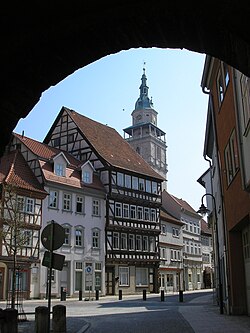Bad Langensalza
| Bad Langensalza | ||
|---|---|---|

in the historical center of Bad Langensalza
|
||
|
||
| Coordinates: 51°6′29″N 10°38′48″E / 51.10806°N 10.64667°ECoordinates: 51°6′29″N 10°38′48″E / 51.10806°N 10.64667°E | ||
| Country | Germany | |
| State | Thuringia | |
| District | Unstrut-Hainich-Kreis | |
| Government | ||
| • Mayor | Bernhard Schönau (FDP) | |
| Area | ||
| • Total | 123.11 km2 (47.53 sq mi) | |
| Population (2015-12-31) | ||
| • Total | 17,483 | |
| • Density | 140/km2 (370/sq mi) | |
| Time zone | CET/CEST (UTC+1/+2) | |
| Postal codes | 99941–99947 | |
| Dialling codes | 03603 | |
| Vehicle registration | UH | |
| Website | www.bad-langensalza.de | |
Bad Langensalza (until 1956: Langensalza) is a spa town of 17,500 inhabitants in the district of Unstrut-Hainich, Thuringia, Germany.
It was first mentioned in historical records ca. 932, as a village named "Salzaha". The city name was changed to Langensalza ca. 1578, and "Bad" or "Bath" was added to the city name in 1956.
In 1075, Langensalza was the site of a battle, in which Emperor Henry IV won over the rebelling Saxons and Thuringians.
The city was plundered and damaged by fires during the Thirty Years' War (c. 1632). Fires again destroyed large parts of the city in 1711, including complete destruction of the city hall. The city hall was rebuilt between 1742-1752.
War again affected the city during 1756-1763, during the Seven Years' War; it was the scene of a battle in February 1761. In 1815 Langensalza became part of the Prussian Province of Saxony. In 1866 it was again the site of a battle between Prussia and Hanover during the Austro-Prussian War.
American troops occupied the city in 1945.
The elections in May 2014 showed the following results:
Langensalza is something of a tourist spot, with picturesque ruins of a medieval castle, and sulphur baths nearby.
The sulphur baths were discovered in 1811, and opened to the public as a curative bath in 1812. A new version of the public sulphur bath was opened in 1928. Salt and mineral water springs were discovered in 1996, which prompted the opening of many new curative facilities.
...
Wikipedia



